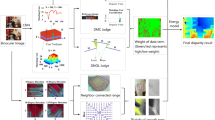Abstract
Most proposed algorithms for solving the stereo correspondence problem have used matching based in some way on linear image features. Here the geometric effect of a change in viewing position on the output of a linear filter is modeled. A simple local computation is shown to provide confidence intervals for the difference between filter outputs at corresponding points. Examples of the use of the confidence interval are provided. For some widely used filters, the confidence intervals are tightest at isolated vertical step edges, lending support to the idea of using edge-like features in stereopsis. However, the same conclusion does not apply to image regions with more complicated variation on the scale of the filter support.
Similar content being viewed by others
Explore related subjects
Discover the latest articles, news and stories from top researchers in related subjects.References
R.D., Arnold and T.O., Binford, “Geometric constraints in stereo vision”, Proc. Spie, San Diego, vol. 238, pp. 281–292, 1980.
H.H. Baker and T.O. Binford, “Depth from edge and intensity based stereo”, PROC. SEVENTH INT. JOINT CONF. ARTIF. INTEL., August, Vancouver, pp. 631–636, 1981.
S.T., Barnard and W.B., Thompson, “Disparity analysis of images”, IEEE Trans. Pami-2(4), pp. 333–340, 1980.
P., Burt and B., Julesz, “A disparity gradient limit for binocular fusion”, Science, vol. 208, pp. 615–617, 1980a.
P., Burt and B., Julesz, “Modifications of the classical notion of Panum's fusional area”, Perception, vol. 9, pp. 671–682, 1980b.
P., Burt and B., Julesz, “The disparity gradient limit for binocular fusion: an answer to J.D. Krol and W.A. van de Grind”, Perception, vol. 11, pp. 621–624, 1982.
D.B. Gennery, “A system for stereo computer vision with geometric models”, PROC. INTER. JOINT CONF. ARTIF. INTEL., Cambridge, MA, pp. 576–582, 1977.
W.E.L., Grimson, “A computer implementation of a theory of human stereo vision”, Phil. Trans. Roy. Soc. London, vol. B292, pp. 217–253, 1981.
W.E.L., Grimson, From Images to Surfaces: A Computational Study of the Human Early Visual System. MIT Press: Cambridge, MA, 1981.
W.E.L., Grimson, “Computational experiments with a feature based stereo algorithm”, IEEE Trans. Pami-7(1), pp. 17–34, 1985.
M.J. Hannah, “Computer matching of areas in stereo images”, Stanford Artificial Intelligence Laboratory memo, AIM-239, July 1974.
M., Kass, “Computing visual correspondence”, Proc. Arpa Image Understanding Workshop, Washington D.C., pp. 54–60, 1983. Reprinted in A., Pentland (ed.), From Pixels to Predicates. Ablex: Norwood, NJ, 1986.
M. Kass, “A computational framework for the visual correspondence problem”, PROC. EIGHTH INT. JOINT CONF. ARTIF. INTEL., Karlsruhe, W. Germany, August, pp. 1043–1045, 1983.
M. Kass, “Computing visual correspondence”, S.M. thesis, Department of Computer Science and Electrical Engineering, Massachusetts Institute of Technology, 1984.
J., Koenderink and A.van, Doorn, “Geometry of binocular vision and a model for stereopsis”, Biological Cybernetics, vol. 21, pp. 29–35, 1976.
J.D., Krol and W.A.van de, Grind, “Rehabilitation of a classical notion of Panum's fusional area”, Perception, vol. 11, pp. 621–624, 1982.
D., Marr and E., Hildreth, “Theory of edge detection”, Proc. Roy. Soc. (London), vol. B207, pp. 187–217, 1980.
D., Marr and T., Poggio, “A theory of human stereo vision”, Proc. Roy. Soc. London, vol. B204, pp. 301–328, 1979. (An earlier version appeared as MIT AI Lab Memo 451, 1977.)
J., Marsden, Elementary Classical Analysis. Freeman: San Francisco, 1974.
J.E.W., Mayhew and J.P., Frisby, “Psychophysical and computational studies towards a theory of human stereopsis”, Artificial Intelligence, vol. 17, pp. 349–385, 1981.
G.G. Medioni and R. Nevatia, “Segment-based stereo matching”, PROC. DARPA IMAGE UNDERSTANDING WORKSHOP, Washington, D.C., June, pp. 128–136, 1983.
H.P. Moravec, “Towards automatic visual obstacle avoidance”, PROC. FIFTH INT. JOINT CONF. ARTIF. INTEL., Cambridge, MA, p. 584, 1977.
K., Mori, M., Kododi, and H., Asada, “An iterative prediction and correction method for authomatic stereo comparison”, Computer Graphics and Image Processing, vol. 2, pp. 393–401, 1973.
H.K. Nishihara, “PRISM: A practical realtime iamging stereo matcher”, PROC. THIRD INT. CONF. ROBOT VISION AND SENSORY CONTROLS, SPIE Cambridge Symposium on Optical and Electro-Optical Engineering, November, p. 449, 1983.
Y., Ohta and T., Kanade, “Stereo by intra- and interscanline search using dynamic programming”, IEEE Trans. Pami-7(2), pp. 139–154, 1985.
S.B., Pollard, J.E.W., Mayhew, and J.P., Frisby, “PMF: A stereo correspondence algorithm using a disparity gradient limit”, Perception, vol. 14, pp. 449–470, 1985.
L.H. Quam, “Hierarchical warp stereo”, PROC. IMAGE UNDERSTANDING WORKSHOP. Science Applications International, 1984.
D., Terzopoulos, “Multilevel computational processes for visual surface reconstruction”, Computer Vision, Graphics and Image Processing, vol. 22, pp. 39–69, 1983.
V. Torre and T. Poggio, “On Edge Detection”, IEEE TRANS. PAMI-8(2), 1986.
C.W., Tyler, “Stereoscopic vision: cortical limitations and a disparity scaling effect”, Science, vol. 181, pp. 276–278, 1973.
C.W. Tyler, “Spatial limitations of human stereoscopic vision”, PROC. SPIE, vol. 120, 1977.
A. Witkin, D. Terzopoulos, and M. Kass, “Signal matching through scale space”, INT. J. COMPUTER VISION, vol. 2, 1987.
Author information
Authors and Affiliations
Rights and permissions
About this article
Cite this article
Kass, M. Linear image features in stereopsis. Int J Comput Vision 1, 357–368 (1988). https://doi.org/10.1007/BF00133572
Issue Date:
DOI: https://doi.org/10.1007/BF00133572




